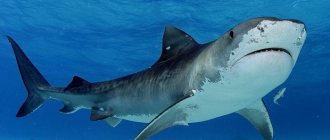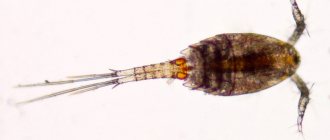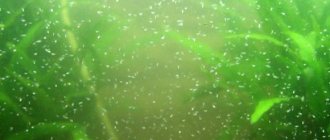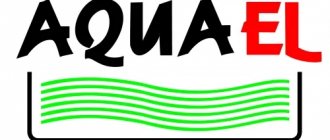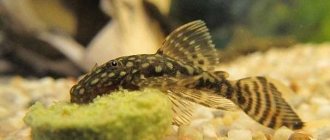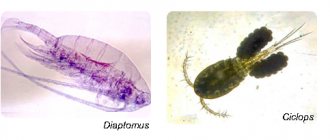FORUMHOUSE fish farmers sometimes feed their carp and grass carp with cucumber and lettuce; they breed maggots so that the fish do not suffer from a lack of protein, and generally demonstrate the highest class in providing fish with “a varied, tasty and healthy diet, balanced in amino acids, vitamins and minerals.”
LyalechkaFORUMHOUSE user
I want the fish to be tasty and healthy. Like everything else.
The topic of feeding fish is huge; in this article we will focus on the standards and method of preparing grain feed and the types of green additives in the fish diet. We will talk about methods of making feeders and choosing feeding places, feeding times, methods of attracting insects to the pond and growing maggots in the following articles.
Historical facts
The first mentions of artificial reservoirs with inhabitants of the water element date back to Ancient Egypt. The paintings of some ancient temples contain images of fish kept in home ponds.
The most common fish among the Egyptians was the African tilapia fish. In addition to it, in ancient drawings you can see catfish, elephant fish, mormirus, and chromis.
The Egyptian tradition was continued by the famous ruler of Babylon, Nebuchadnezzar, who decorated the gardens of his beloved wife Amytis with ponds and pools with fish.
They kept fish in Ancient Rome, but this type of activity gained particular popularity in China and Korea, and then in Japan. It was in the East that they learned to create amazingly beautiful goldfish.
By the 15th century, about forty species of unusual fish had been bred. About a century later, rumors about strange creatures reached Europe, and later the fish themselves appeared in the ponds of the royals of the old world.
Crushing, steaming, germination
Pond fish can be fed simply with wheat, not prepared in any way. But feed preparation methods are directly related to feed efficiency. Experts recommend crushing the grain in a crusher, and the smaller the fish, the finer the grain should be crushed.
Steaming improves the taste of the grain, because part of the starch is converted into sugar (the grain, poured into a container in a layer of no more than a meter, is poured with water at a temperature of 90 degrees, mixed, closed and left for 4 hours).
Of all the types of food preparation for pond fish, wheat germination is the most popular at FORUMHOUSE. It is eaten almost completely by carp.
Aleksej2000FORUMHOUSE Member
For me, there’s nowhere easier than to germinate wheat. He poured wheat into a bag and threw it into the water, the next day he took it out and put it on land, on the third day the food was ready.
Alexey’s preparation of sprouted wheat is put on a conveyor belt: he took one bag out of the water, immediately filled it up and threw another into the water, and feeds the fish with wheat from the third. The whole job takes literally two minutes.
The photo below shows sprouted wheat that a FORUMHOUSE member with the nickname hrr fed the fish in his pond.
According to our authoritative fish farmers, the wheat here is over-seasoned; it was possible (and necessary) to feed two days ago.
11fishForumHouse Member
Only the root will come out, literally 2-3-4 mm, and feed it!
Compound feed for feeding fish is worse than a combination of steamed or sprouted wheat and natural plant and animal food from the pond. It is mainly used for financial reasons, when it costs less than cereals and gives greater growth to the fish, or when one wants to reduce labor costs - unlike wheat. There is no need to steam it or germinate it, just throw it in the pond and you are free.
Feed recipe for growing carp in ponds, %
Some fish farmers combine feeding with grain and mixed feed.
Cool2000FORUMHOUSE Member
There is an old method of the Soviet fish farmer Shcherbina (1968, I think) - carp on an industrial scale were fed mixed feed + wheat 45:55.
Carps eat white loaves with great pleasure.
ikar92FORUMHOUSE Member
The carps eat them, they even fight, but they don’t like bread.
To prevent pieces of bread from being spread all over the pond, you can throw it to the fish in a feeder made of a plastic pipe - by the way, you can always see if you haven’t eaten enough, and the fish are always in sight.
Content
An aquarium is a decoration for an apartment. Admiring goldfish is a great pleasure.
However, aquatic creatures require certain conditions of detention:
- Appropriate temperature conditions;
- A certain area of water;
- Availability of oxygen;
- High quality food.
The short life of aquarium beauties can be further shortened if they are not properly maintained and fed.
Proper nutrition affects almost every aspect of a goldfish's life:
- Immunity;
- Appearance;
- The ability to give birth.
The assortment of zoological stores offers a wide selection of a wide variety of foods.
You need to have an idea of the best foods for your aquarium fish.
Omnivorous fish
Most fish kept in a freshwater aquarium are classified as omnivores. They usually exhibit opportunistic behavior, gobbling up any food they come across along the way. For the most part, they pick up everything that can fit in their mouth - be it food of plant or animal origin, for example: caviar, fry, insects and plant material. Obviously, it is much easier for these fish to feed inside the aquarium, since they will take most of the food if it is of the appropriate size and appears at the same level of the aquarium where they usually stay.
Kinds
Experts divide feed into two categories - long-term and limited shelf life.
The first category includes dry food for aquarium fish. The second group includes the so-called live food, which has a limited shelf life.
Opinion No. 9. Enhancing color with food is real
Color in fish comes from three coloring pigments that are present inside cells called chromatophores. These pigments are: erythrin (red), melanin (black) and xanthine (yellow), each of which is found in other chromatophores. Complementary coloring pigments are iridocytes, which visually closely resemble tiny reflective spheres within the skin. All the colors that freshwater fish are painted in are a mixture of these components. For example, the color orange is a combination of red and yellow chromatophores; brown is a mixture of black and yellow, while red is the result of red chromatophores alone. If there are no chromatophores, the fish will appear white due to the presence of iridocytes, or will show a background color of skin and muscles. Most fish, however, cannot create their own color pigments and must therefore obtain them through their food. In the wild, these pigments enter the body of fish when they eat seaweed, shrimp, snails and other aquatic organisms.
"Red parrots" are artificially bred fish. They were first bred by fish breeders in Taiwan in 1986. The intensity of their color directly depends on the color-enhancing food. (Pictured: Gummy Parrot)
In the limited space of an aquarium, algae or other natural sources of such pigments are clearly not enough, so they must be included in fish food. Color enhancing foods must be of high quality to ensure that the pigments are of the correct form to be effectively absorbed by the fish. Color-enhancing ingredients in fish food can be either natural or artificial, but in either case they must be a source of the pigments mentioned earlier. Natural components rich in coloring pigments that can be absorbed by fish include foods such as krill, spinach, spirulina algae and carrots. If it is necessary to optimize the color of fish, food for them should be selected taking into account the presence of these components.
Selection rules
When choosing dry food for your fish, you should be guided by one rule - to help, and not harm, the inhabitants of the aquarium. Poor quality granules quickly disintegrate in water and pollute the water.
When purchasing, you need to pay attention to the following points:
- Shape and material of packaging;
- Shelf life;
- Product storage location.
Vitamins A and D 3 are light sensitive and the wrapper should protect the contents as best as possible. Food in plastic bags, as well as those sold by weight, do not meet basic sanitary standards and therefore it is better to refuse to purchase them.
The shelf life of the product is no less important. Very often, there are products on store shelves that are approaching their expiration date. Such food can be harmful to aquarium fish.
If food is stored on a store display for a long time, a number of useful microelements may disappear from it. Products stored in a damp room are at even greater risk - the risk of fungi and mold forming inside the packaging is very high.
Opinion No. 5. The composition of the feed is determined by the feeding needs of the fish.
There are a wide variety of aquarium fish species that can be kept in a freshwater aquarium. And although many of them can live peacefully with each other, their dietary requirements are sometimes noticeably different from each other. In the wild, representatives of aquarium fish species feed on a very wide range of foods, from microscopic algae to whole fish carcasses - and in some cases even pieces of flesh “gnawed off” from land animals. In their natural environment, fish prefer to congregate in places where food is found in greatest abundance (taking into account the fact that other conditions suit them there, for example, water parameters). If there is not enough food, or it does not meet the feeding requirements of a given species, the fish move to another area, and if this is not possible, they will most likely starve. Inside the aquarium, the situation is completely different: the fish expect that their favorite food will appear in a set place at a set time, and there will be enough of it for them to have a satisfying snack. For example, the wide range of food presented by our company is able to satisfy any – sometimes even very bizarre – nutritional needs of fish, providing them with proper balanced nutrition, which helps improve immunity and health. According to the method of obtaining food, fish can be divided into three groups: herbivores, predators and omnivores. How are they different? Herbivorous fish Herbivorous fish are species that feed either exclusively on plant material or primarily on plant food. This group includes species such as: Sumatran hramuli, otocyclus catfish, bream barbs, plecostomus catfish and Malawian cichlids.
These fish have many features that allow them to feed on plant material. One of them is a specially adapted intestine, which can be 2-3 times longer than the body itself, while the stomach as we know it is absent. The length of the intestine allows the fish to assimilate plant and algal material as well as possible, which in itself is difficult to digest. Despite their long intestines, herbivores must eat regularly, in other words, they must get enough food to survive. This behavior can be observed, for example, in mollies or plecostomus, which now and then graze on some areas of aquarium algae clinging to the aquarium. To successfully keep herbivorous fish, it is important to provide them with food rich in plant material. There are a variety of foods available, consisting of flakes, flakes, sticks, granules and tablets that provide the ideal basis for their diet. They can be supplemented with tablets consisting mostly of seaweed, as well as fresh vegetables, such as slices of cucumber or peas. Due to the fact that plant material is not digested very efficiently compared to protein, the life processes of herbivores produce more waste than all other fish. However, the low protein content in plants prevents the water from becoming very polluted.
Top brands
Among the best manufacturers of food for aquarium fish, experts note the following:
- German Tetra.
- Japanese "Hikari".
- Polish "Tropical".
The German brand offers high-quality food for all breeds of aquarium fish in the form of balls, tablets, sticks, etc.
The Japanese company produces both floating and sinking premium food. Dry food contains proteins, grains, fats, and vitamin complexes.
The Poles produce more than two hundred feeds containing vitamins. The line of cheap but high-quality food includes universal, medicinal, and special products.
Opinion No. 12. Beta-glucan in food is the key to good immunity in fish
Only AZOO brand food contains glucan in all types of fish food. This measure allows you to strengthen the immunity of fish and significantly increase their resistance to bacterial, viral and parasitic diseases. It is easier to prevent a disease than to treat it. By consuming food with beta-glucan, fish become energetic and cheerful. Azoo's glucan is extracted from the cell walls of a rare traditional Chinese medicinal plant (Ganoderma lucidum). Therefore, it is not found in food from other brands. You can read more about beta-glucan here: https://marlin-shop.ru/article/26/ We hope that this article will help aquarists reconsider long-established stereotypes in the field of fish feeding and will give them the opportunity to use our practical advice for the benefit of their pets .
Frozen bloodworm is an excellent natural additive for all dry food, helping not only to improve health, but also to stimulate fish to spawn
You can buy frozen (live) fish food here https://marlin-shop.ru/category/zamorozhennye-korma-dlya-ryb/
The text is based on: Reference: Tom Barthel – “Latest News From the Fish Food Front” – “Aquarium Fish International” Publication Dr. David Pool – “Feeding aquarium fish” – “Popular Fish Keeping” Publication David A. Lass and Michael J. Massie – “Rethinking The Way You Feed Your Fish” – “Aquarium Fish International” Publication
Selection of live foods
Among aquarists, so-called live food is very popular;
- Bloodworm;
- crustaceans;
- Larvae;
- Worms;
- A special type of mosquito is the coretra.
When buying live food, you should pay attention to its mobility, smell and color.
The bloodworms should be bright scarlet, the core should be translucent, and the crustaceans, larvae and worms should be active and mobile.
The aroma of high-quality live food resembles the smell of fish and algae. A sign of spoilage is a pronounced foul smell of rot and mold.
Opinion No. 10. Treats can lure fish out of hiding.
Many commercial foods are labeled as 'complete' on their packaging. This means that they are designed to provide all the nutrients your fish need. In addition to “complete” foods, there are treats. The latter are found in various forms: from live food to living organisms. For example, food tablets that stick to the front glass are a great treat because they lure fish directly to the front of the aquarium where they can be seen clearly. Such treats should be given 2-3 times a week, using them on such days instead of regular food.
Making your own feed
Unforeseen moments arise in life. It may happen that the special food suddenly runs out, and the goldfish need to be fed urgently. Experienced veterinarians advise how to make food for aquarium fish with your own hands. Here are some similar methods:
- Raw meat, deveined, can be used instead of live food. Using a knife, scrape off as small pieces as possible from the meat and give it to the fish in this form.
- Boil buckwheat, semolina or wheat groats until it becomes a thick porridge. Then the food is thoroughly washed under running water and filtered through a sieve. Labyrinthine and carp fish species eat such food with pleasure.
Remember! This type of feeding should only be given as a last resort!
- Large aquarium specimens will readily eat earthworms. Before serving, the worms should be thoroughly washed and chopped. Some veterinarians advise disinfecting worms in a weak solution of potassium permanganate.
- The most commonly used frozen food for aquarium fish is beef heart. The product is grated and offered to the fish every few days.
- The yolk is taken out of a hard-boiled egg, grated and given to the fish.
- In exceptional cases, you can feed the hungry inhabitants of the aquarium with crumbs of stale white bread.
Wheat is the basis of the diet
The basis of the fish diet is cereal grains, in descending order of nutritional value: wheat, barley, rye, oats. From a kilogram of wheat, carp absorbs half a kilogram of nutrients, the nutritional value of barley is approximately the same, but its protein is less easily absorbed by fish, and in general it gives less growth; rye, on the contrary, uses protein for an increase of more than 70%, but fish generally eat it poorly. Oats are also characterized by low productivity and low nutritional value; they are given to fish only as part of feed mixtures, in small quantities and preferably cleared of films .
ForeignerForumHouse Member
Here is my feeder - equal parts of wheat, corn and millet.
Daily norms for feeding two-year-old carp with grain (% of fish weight)
Breeding live food
Manufacturers of fish food saturate their products with essential beneficial elements. However, despite this, fish are always more attracted to live food, and besides, live food is more nutritious and healthier than dry food.
It is unlikely that any aquarium owner will decide to breed such food for aquarium fish as mosquitoes or worms. But it is quite possible to obtain the simplest organisms - crustaceans, ciliates.
- It is very easy to get such necessary food for fry as a shoe.
- Add milk, cream, fruit peels, carrots to a jar of water and place in a bright place.
- The temperature should be kept within +20°C.
After about a week, the water will become cloudy, and after another ten days it will become transparent and ciliates will be clearly visible in it. The resulting “nutrient broth” can be frozen in plastic bags and fed to the fry as needed.
How to make it yourself
You can make 2 types of food yourself: live and plant-based. In addition, you can periodically pamper your pets with dishes “from your table,” but this also needs to be done correctly.
Let's first learn how to fully feed the fish with our own efforts, without turning to stores for help:
- Plant food. It turns out that aquarium pets are not averse to eating various greens and even vegetables. They can be given fresh or defrosted plant food.
For example, green peas, cucumbers, various types of salads and spinach. This diet is suitable for herbivores and omnivores. It is recommended to pre-boil and crush the peas so that they are easier to digest. Spinach is blanched before use. This also needs to be done with lettuce so that the complex fiber that is not digestible by the fish is destroyed.
- Animal food. It is also actively used in growing and feeding fish. Many breeders advise feeding the fish with boiled meat (beef, especially heart and liver), but it is given rarely and in small quantities. The fact is that such food leads to the accumulation of fat in the pets’ organs, which can cause illness and death.
If you still want to feed your fish animal food, give them raw meat from thawed shrimp, shellfish (mussels are ideal), and other fish.
- Live food. It can also be used fresh, but it is better to use it after defrosting, then all harmful organisms will definitely die. The same bloodworm is found in all muddy reservoirs. It is extracted by washing bottom sediments. Daphnia is excellent for breeding at home; young animals are fed with it. The tubifex is also extracted from the bottom along with silt and washed several times.
However, before giving any independently caught culture to fish, it must be kept in settling water for at least 3 days. During this time, the intestines of invertebrates will be freed from what they ate in the wild, and the risk of infecting pets will be significantly reduced.
For complete and balanced nutrition, fish must consume different types of feed. Therefore, even when making food for her yourself, do not forget about variety.
Feeding rules
Inexperienced or novice aquarists often overfeed their pets. A large amount of food thrown into the aquarium leads to the fact that food residues quickly decompose, release ammonia, and therefore pollute the water. All this causes the death of fish.
At one time, you need to give the goldfish as much food as they can eat in five minutes.
If you miscalculate and throw more food into the aquarium, it must be removed before it begins to decompose. In an aquarium with a large capacity and with many inhabitants, bait should be carried out two to three times a day. The exception is aquariums with predatory fish - two to three meals a week are enough for them.
Why do fish spit out food?
Sometimes it happens that no matter what food is offered to the fish, they spit it out. There are several reasons:
- The food is not suitable. It may not correspond to the taste preferences of the fish, then simply changing the food is enough. In addition, the meals offered may not be appropriate in size. The problem is also solved by changing the power supply.
- The fish are overfed. As mentioned above, the peculiarity of keeping pets is that they need to be underfed. If the fish spit out food, just keep them hungry for a few days.
- Some diseases manifest themselves in this way. But this is another topic, and needs to be discussed separately.
Food for aquarium fish is an important aspect of their proper and full existence. Therefore, every owner takes the choice of food seriously.
At the end of today’s conversation, we present a table of the price ratio for different types of feed in the five largest cities of Russia: Moscow, St. Petersburg, Novosibirsk. Yekaterinburg and Nizhny Novgorod.
Feed prices:
| City/Type of feed | Alive | Dry | Frozen |
| Moscow | Bloodworm 200 rub. (100 g), 2000 (kg) Maggot 50 (100 g) - 1200 (kg) | Average price 200-500 rubles depending on brand and volume | The price of one blister of 100 ml is from 50 rubles (depending on the type). Packs 10 pcs. – about 900 rub. |
| Saint Petersburg | 50-800 rubles depending on the manufacturer and volume | 200-1000 rubles depending on the manufacturer and volume | 80-200 rubles depending on the manufacturer and volume |
| Novosibirsk | On average, 100-200 rubles per serving (100 g). | 100-800 rubles depending on the manufacturer, composition and volume, average price 400 rubles | Blister 100 ml on average 70 rubles. |
| Ekaterinburg | On average 100-200 rubles for a standard portion of 100 g | From 30 rubles per package (30 g) to 2000 (combined mixtures with a volume of more than 1-11 l) | 50-100 rubles for one 10 ml blister |
| Nizhny Novgorod | On average 150 rubles per serving | From 30 rubles for 25 g to 4000 rubles for several liters | On average, for 100 g from 20 to 80 rubles, depending on the type of organisms |
Photo of the best food for aquarium fish
What not to feed
If you buy combined dry food, carefully read the composition - the ingredients should not include the following:
- Wheat flour;
- wheat gluten;
- soy flour;
- potato starch;
- inositol
All of the listed ingredients contain too many carbohydrates, which aquarium fish living in confined spaces simply do not need.
Did you know? Today there are over 32 thousand fish in the world, and every year the list is replenished by 300
–
500 new species.
What to do if your fish don't eat dry food well
There may be several reasons for refusing dry food:
- Adaptation period. If you have just acquired new underwater inhabitants, they can adapt to the aquatic environment, lighting, and neighbors within a week. One of the manifestations of the adaptation mechanism is precisely the refusal to eat. Usually after a week the fish gets used to it and begins to eat the food offered.
- Violation of maintenance conditions , including light, temperature, level of water pollution, aquarium volume and population density. Check whether your conditions match the natural needs of the fish you keep and make adjustments if necessary.
- Feeding preferences. This point is related to the first one - if you recently purchased a fish, then it can adapt not only to new living conditions, but also to its diet. Your dry food may be unfamiliar, unattractive, and suspicious to her. Try changing the manufacturer's brand or product type.
- Product type/shape/size mismatch. If you use granules or tablets, make sure they are not too big for your fish's mouth.
- Diseases. Refusal to eat is a very common accompaniment of many ailments of aquarium inhabitants. Examine the fish and note any other manifestations, then contact the pet pharmacy for medications.
- Constipation. In this condition, the fish refuses food and does not defecate. It usually goes away on its own after a couple of days.
- Recent overfeeding. In this case, 1–2 fasting days will be required.
- Poor product quality. It needs to be replaced with a better brand.
- Carrying eggs in the oral cavity (in some species).
- Oral trauma and stress resulting from altercations with other aquarium inhabitants. Species that conflict with each other must be placed in separate tanks, otherwise a similar problem cannot be avoided.
Thus, dry food is a very important and significant component of the diet of aquarium fish; for some species it is the basis of nutrition. But for the health of your underwater pets, it is important not only to choose a high-quality and suitable product, but also to follow the feeding rules.


